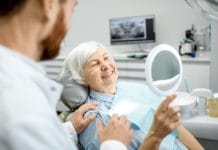“Scientists have discovered a revolutionary new treatment that makes you live longer. It enhances your memory, makes you more attractive. It keeps you slim and lowers food cravings. It protects you from cancer and dementia. It wards off colds and flu. It lowers your risk of heart attacks and stroke, not to mention diabetes. You’ll even feel happier, less depressed and less anxious. Are you interested?”
Of course, you are interested! Who wouldn’t be interested in this miracle treatment? Well I have some good news! We all have access to it because this miracle treatment is sleep. And not just sleep, but uninterrupted sleep. The above excerpt is from the book Why We Sleep written by Matthew Walker, a professor of neuroscience and psychology at UC Berkley. According to the American Sleep Apnea Association, 22 million Americans suffer from sleep apnea, with 80% of the cases being undiagnosed moderate and severe sleep apnea1.
Often we relate sleep apnea with obese adults. However, sleep-related breathing disorders do not have an age range, and some of our youngest patients are being overlooked when screening for sleep-related breathing disorders. Obstructive sleep apnea (OSA) in children has emerged not only as a relatively prevalent condition but also as a disease that imposes a large array of morbidities, some of which may have long-term implications, well into adulthood.2 Screening for sleep apnea in both adults and children should be something we do at all dental appointments; however, I would like to focus on screening children.
As adults, we know when we don’t sleep well, and we can easily report our symptoms to our doctor. Generally, children do not realize they have had fragmented or disturbed sleep; they don’t know to tell their parents, and many parents do not know the symptoms of fragmented sleep in their children. This is where we, as dental professionals, can contribute to this problem by screening the pediatric patient, educating the parents, and referring patients for further evaluations by other medical and dental professionals.
When screening a child for OSA, there should be a combination of questions asked to the parents as well as physical observations. The etiology of childhood OSA is quite different from that of the adult condition. In adults, OSA is usually associated with obesity and other causes. Obese children are at risk for OSA, and the degree of OSA is proportional to the degree of obesity. However, most children with OSA are not obese. In fact, they may have a failure to thrive.3
Chronic mouth breathing and snoring are two primary factors to consider when screening the patient. When performing an oral evaluation, screening for oral manifestations indicative of mouth breathing are imperative, as they are a major contributing factor in OSA. Indications of mouth breathing include a high and narrow hard palate, long face, class II malocclusion, crowded dentition and/or crossbite, ankyloglossia, and venous pooling under the eyes often referred to as “allergy shiners.”
Another contributing factor that should be considered when screening for OSA is tonsillar hypertrophy. While enlarged tonsils and adenoids were thought to be the primary cause of OSA in children, new research has proven this is not always the case. In one study enlarged tonsil, when present, were only noted in later examinations in children who exhibited mouth breathing, high and narrow hard palates, and mouth breathing during sleep. The hypothesis that the enlargement of tonsils occurs as a result of mouth breathing and the presence of a high and narrow hard palate is supported in this study.4 In many cases, children do improve following adenotonsillectomy, but later have a recurrence of OSA as a teenager. Complete resolution of OSA following adenotonsillectomy was successful in only 51% of non-obese prepubertal children.4
Bruxism and significant movement throughout the night are also symptoms of OSA. It is believed that triggers for sleep bruxism and movement are airway related. Questions to ask the parents for a thorough assessment would include: Does your child snore or mouth breathe when sleeping? Does your child grind their teeth when sleeping? Does your child have significant movement at night?
After completely screening the patient, and educating the parent on your findings, a referral to an orofacial myofunctional therapist (OMT) and an orthodontist could be beneficial. Studies show that orthodontists can help manage OSA in children. Rapid maxillary expansion might aid in the improvement of the quality of life for children with narrow maxilla in the milder-end of the sleep-disordered breathing spectrum.5 It is important to refer children at an early age for an orthodontic consult if they have signs of OSA because it is imperative to have treatment before complete facial growth is attained. Also, the current literature demonstrates that myofunctional therapy decreases apnea-hypopnea index by approximately 62% in children. Therefore myofunctional therapy could serve as an adjunct to other OSA treatments.6
Other issues associated with OSA are cognitive-behavioral problems. Behavioral manifestations of children with OSA may be very similar to those with attention deficit hyperactivity disorder. Both the disorders may present with symptoms of hyperactivity, inattentiveness, and poor academic performance.3 While there is a possibility that affected children will “grow out of” their sleep disorders, the evidence is steadily growing that untreated pediatric sleep disorders, including sleep apnea, can wreak a heavy toll while they persist.
Studies have suggested that as many as 25% of children diagnosed with attention-deficit hyperactivity disorder may actually have symptoms of obstructive sleep apnea and that much of their learning difficulty and behavior problems can be the consequence of chronic fragmented sleep.7 Behavior problems and mental development significantly improved in children following treatment for OSA.8
Though it will require a multidisciplinary team to achieve early diagnosis and appropriate treatment, I would like to encourage all dental professionals to begin screening for OSA and to make it part of your routine. With early intervention and diligent screening, dental professionals can improve quality of life in children suffering from OSA.
Now Listen to the Today’s RDH Dental Hygiene Podcast Below:
References
- https://www.sleepapnea.org/learn/sleep-apnea-information-clinicians/
- Sans Capdevila O, Kheirandish-Gozal L, Dayyat E, Gozal D. Pediatric obstructive sleep apnea. Proc Am Thorac Soc 2008 Feb 15; 5(2): 274-282 Retrived from http://www.atsjournals.org/doi/abs/10.1513/pats.200708-138MG
- SK Verma, S Maheshwari, NK Sharma, K.C. Prabhat Role of oral health professionals in pediatric obstructive sleep apnea. Natl J Maxillofac Surg. 2010 Jan-Jun; 1(1): 35-40 Retrieved from https://www.ncbi.nlm.nih.gov/pmc/articles/PMC3304178/
- Yu-Shu Huang, Christian Guilleminault. Pediatric obstructive sleep apnea and the critical role of oral-facial growth: evidence. Frontiers in Neurology 2013 Jan Vol 3 Article 184 Retrieved from https://www.ncbi.nlm.nih.gov/pmc/articles/PMC3551039/
- Katyal V, Pamula Y, Daynes CN, Maartin J, Dreyer CW, Kennedy D, Sampson WJ. Craniofacial and upper airway morphology in pediatric sleep-disordered breathing and changes in quality of life with rapid maxillary expansion. American Journal of Orthodontics & Dentofacial Orthopedics. 2013 Dec Vol 144 Issue 6 Retrieved from https://www.ncbi.nlm.nih.gov/pubmed/24286909
- Macario Camacho, Victor Certal, Jose Abdullatif, Soroush Zaghi, Chad M. Ruoff, Robson Capasso, Clete A. Kushida; Myofunctional Therapy to Treat Obstructive Sleep Apnea: A Systematic Review and Meta-analysis, Sleep, Volume 38, Issue 5, 1 May 2015, Pages 669–675 Retrieved from https://www.ncbi.nlm.nih.gov/pubmed/25348130
- https://www.sleepapnea.org/treat/childrens-sleep-apnea/
- Emi Murata, Ikuko Mohri, Kumi Kato-Nishimura, Jiro Iimura, Makoto Ogawa, Masaya Tachibana, Yuko Ohno, Masako Taniike. Evaluation of behavioral change after adenotonsillectomy for obstructive sleep apnea in children with autism spectrum disorder. Research in Developmental Disabilities. 2017 Jun; Vol 65 Pages 127-139 Retrieved from https://www.sciencedirect.com/science/article/pii/S0891422217301087












